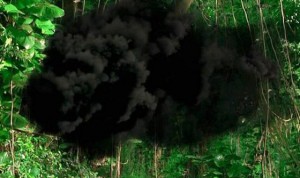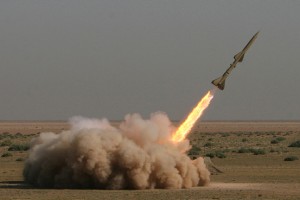As the main stream media slip back into their pre-2009-Iran-presidential-election coma of blissful ignorance, the story is no longer about the courageous Iranian protesters facing their government and revealing to the world how their government torments and terrorizes them. The now almost decade long story about the threat of the Iranian nuclear program has started another episode.
It’s kind of like the TV series, Lost. You get a sense that something bad is out there–danger is imminent– the threat is dark, but undefined, constantly shifting and changing its shape, disappearing and reappearing–a sort of smoke monster:

(the “smoke monster” from the Lost TV series)

(picture of launching Iranian missile)
Incidentally, Lost was one of the most popular bootlegged DVDs in Iran recently.
Perhaps Iranians feel like they can relate with of a group of people stranded on an island, isolated from the world and under constant threat of the unknown “out there” or the Others lurking on the island who torment them. Or perhaps they just find the show entertaining. Maybe it’s a bit of both.
The story of Iran has had so many twists and turns in the last century, and for almost one third of that time the Islamic Republic has reigned in Iran. A reign of terror on the people of Iran by a despised and feared government masquerading as a democratic and popular one. The Islamic Republic has done a great job portraying a people that once were respected and looked upon generally favorably in the west, as radical, fanatical Islamic zealots hellbent on confrontation with the west. The latter do exist in Iran. They were the ones who beat, shot at and raped and killed people in the streets last year. They are the ones torturing young and old in Iran’s prisons to extract forced confessions from them. But they are nowhere near the majority.
The current leaders of Iran believe that they are paving the way for the return of the twelfth Shia Imam, the Mahdi, to the world. They believe that this is to be accompanied by an apocalyptic holy war. They use the resources of the Iranian people to fund Hezbullah, arming them to the teeth in Lebanon on Israel’s border, all while many of their own people, Iranians, starve or live on the edge of poverty.
Somehow, despite the imposition by the Islamic Republic of 30 years of so-called “cultural revolution” on the Iranian people, one that attempted to wipe the history of Iran prior to Islam from the identity of the wave of children that were born under their reign, the people of Iran managed to keep their identity. They illustrated to the world last year in an uprising that the world witness mostly through Twitter via an information revolution dubbed, the Twitter Revolution, that they seek freedom.
It has now been over fourteen months since the world saw a glimpse of what was really happening in Iran. Although they were very late to report what was coming out of the social media outlets at first, the main stream media did eventually catch on, and for a brief period there was a flowering of something new–a synergy that stretched from the protesters in the streets of Iran to the new media of the Internet, to the main stream media to the people of the world.
Now, fourteen months later, the media have shifted their focus back on Iran’s nuclear program, all while hundreds and possibly thousands of innocent people languish in Iran’s prisons under the most brutal and dire conditions and the constant threat of torture because of their beliefs. The U.N. and various world governments give occasional lip service to the deteriorating human rights situation, but it is nowhere near enough. The polical prisoners of Iran are almost an afterthought. The focus is on the nuclear program.
It makes one wonder if that is not what the government of Iran wants. Could it be possible that like Lost, they have their mysterious smoke monster, and it serves as a good distraction to the internal situation?
It really isn’t rocket science (pun intended) is it? Walks like a duck, quacks like a duck …
Meanwhile there is turbulence and noise in the waters of Iranian politics. Rumblings. Strange things. Unpredictability.
Strikes in Iran’s bazaars. The last time this happened in Iran was during the revolution that overthrew the Shah of Iran, Mohammad Reza Pahlavi.
Hashemi Rafsanjani, former president of Iran under the Islamic Republic, recently stated that he would like to leave politics and “travel the world”.
Issa Saharkhiz, prominent Iranian journalist, who has been held in prision by the regime since shortly after the rigged election, offers a vigorous statement of defense boldly holding the Supreme Leader responsible for the horrible state of affairs in Iran.
The head of the Islamic Republic, Ayatollah Khamenei, recently issued a fatwa, posted on his official website, informing the world that his rule is equal to the prophet, only to remove it, and then post it back up again.
Ahmadinejad says he disagrees with government interference in people’s dress, while morality police harass and harangue Iran’s educated and egalitarian youth, primarily girls–for “bad hejab”. And in Hamedan he says that England is a small island off the coast of West Africa, after an explosion occurs close to his vehicle, variably described as a “grenade” or a “fire-cracker”. Take your pick. The government line is that it was not an assassination attempt.
His controversial (in the Islamic Republic) chief-of-staff, despised by many of the conservative hardlines becomes head of the governments propaganda machine, Islamic Republic of Iran Broadcasting (IRIB).
In Lebanon, Hezbullah leader, Nasrallah, hails Khamenei, calling him at the forefront of our greatest Marjas. In the Shia faith, a Marja, also referred to as a Grand Ayatollah, is considered a “source of emulation”, and is the highest rank in the clergy that can be achieved short of Imam. There are signs of a schism forming in the Shia faith, centered around the concept of Velayate Faghi (Supreme Jurisprudent, and the position currently held by Khamenei) that Khomeini brought to Iran. Khamenei, the IRGC, Hezbullah, and radical ayatollahs like Mesbah Yazdi and Jannati are proponents of the rule of the Velayat and believe that they are the heirs of the Shia legacy. They are marginalizing the Grand Ayatollahs that are opposed to their rule.
Grand Ayatollah Sistani in Iraq recently issued a fatwa saying that the Velayateh Faghi can only rule legitimately if he is supported by the majority of the people. The timing of this, with respect to Khamenei’s “I am the rule of the Prophet” fatwa, is succint.
The opposition presidential candidates Mir Hossein Mousavi and Mehdi Karoubi continue to issue statements condemning the government of Ahmadinejad and even challenging Khamenei. They have not been arrested after fourteen months of resistence to the regime, but they are under constant threat. Karoubi was purportedly attacked recently by supporters of Ahmadinejad.
Seventeen political prisoners are on hunger strike in Tehran’s Evin prison, with reports of heavy pressure on them by prison officials and revolutionary guards members, all while Mostafaei, the attorney of Sakineh Ashtiani (sentenced to death by stoning by Iran’s judiciary) comes out of hiding in Turkey, seeking asylum, while his family members are held hostage by the regime.

